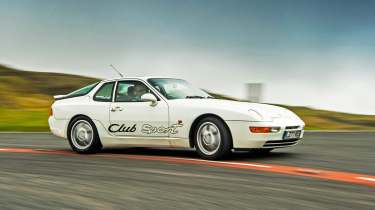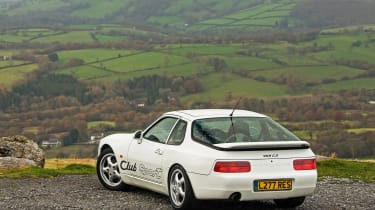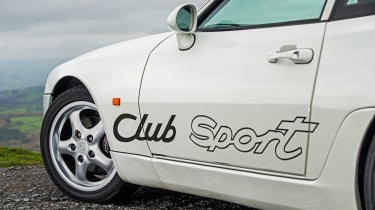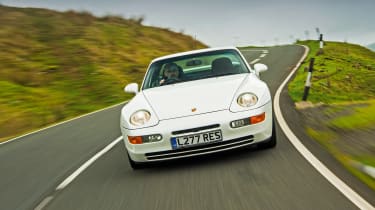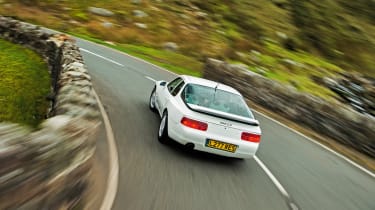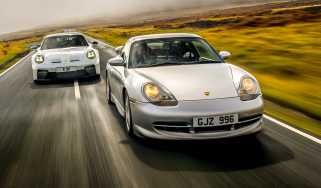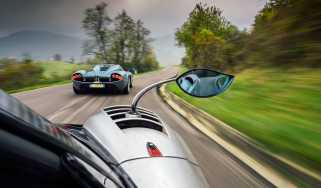Porsche 968 Club Sport - behind the wheel of an icon
Not all track-leaning Porsche specials are 911s. 25 years ago, the unloved entry-level 968 was transformed with a Club Sport makeover
The most famous example of road car evolution at Porsche is, of course, the 911, but I’d argue that the transformation of the 924 into the 968 Club Sport deserves admiration. My first witness for the prosecution is the two-time WRC champion and latter-day consultant to Porsche, Walter Röhrl, who declared in the early ’90s that the 968 Club Sport was the best-handling car that Porsche made.
It helped that some key elements were there from the start, notably the transaxle – the rear-mounted, combined gearbox and differential – which conferred a near-50:50 weight distribution. Lots of other components that helped create the Club Sport what it is made their debut on other models. For instance, the slant-four that is half of the 928’s V8 in concept arrived as a 2.5-litre in the 944, supplanting the original 2-litre Audi four. Lightweight suspension components such as aluminium front and rear suspension arms, hollow anti-roll bars and aluminium wheel nuts were first seen on the 944 Turbo and the 944 S2, as were the bigger Brembo brakes.
> New Porsche 911 2019 review - 992 generation strengthens its armoury against rivals
Intriguingly, late in the 944’s life – after production at Audi’s Neckarsulm plant had ended in ’91 and before the 968 began rolling down the lines at Zuffenhausen in ’92 – there came what can be regarded as something of a precursor to the Club Sport. It was conceived by Porsche GB, was called the 944 S2 SE (Special Equipment), and only 15 were built, all for the UK market. It was remapped to coax 225bhp from the S2’s now 3-litre slant four (up from 208bhp), featured a limited-slip diff and oil cooler, and its chassis was lowered, stiffened and offered some set-up adjustability. At the very least, it showed there was untapped potential.
Porsche claimed that the 968 was 80 per cent new, though whether that was by number of parts, weight, cost or some other measure was not revealed. As well as the new 928-inspired front and rear ends there was a six-speed gearbox in place of the 944’s five-speeder, and the 3-litre engine featured VarioCam, Porsche’s new variable valve timing system which adjusted the inlet cam timing to give better low-down torque and high-rev power.
The Club Sport came along a year after and took all the best bits and combined them into a superbly balanced and unexpectedly satisfying whole, but there was also less to it than that. Deleted items included the rear seats, air conditioning, rear wiper, electronic tailgate release and a chunk of sound deadening, while the electric windows became wind-up and the standard, electrically adjusted Recaros were replaced by lightweight, fixed-back Recaro buckets. The total weight saving was an impressive 50kg, providing, of course, that the customer went for this pauper spec.
‘Club Sport’ was an appropriate name, having been used first for a rather special 911 in the mid-’80s. Like that car, the lightweight 968 had its name writ (optionally) between the wheels in the same style that ‘Carrera’ had been on the 911 2.7 RS of 1972-73. The Club Sport’s 17in alloys could be colour coded to the body, as the shell backs of the Recaros were, in one of just five colours: Speed Yellow, Guards Red, Maritime Blue, Riviera Blue, or Grand Prix White, as shown here.
The first time I got to drive one was for Performance Car magazine on the model’s low-key UK launch in 1993, which was from a hotel somewhere near Aylesbury, I think. I don’t recall how we knew it was going to be such a great driver’s car, but we had a plan. As soon as we got the key to our Maritime Blue example we went straight to the Millbrook proving ground and took a full set of performance figures, then we did a photoshoot on the way back and had all the driving impressions bagged for a full road test before handing the key back again a few hours later.
It was a glowing test report. The Club Sport was fantastically rewarding when you were exploiting all of its grip, but because it was so approachable, intuitive and reassuringly well-sorted, it was also one of those cars that anyone who enjoyed driving could appreciate. I recall arguing that point with a tester from Top Gear magazine. In one of those rare alignments, three magazines published the same three-car test in the same month. The cars were the Club Sport, the Audi S2 and the BMW M3 (E36). We put the Porsche first, Top Gear put the Audi first, and the third mag, Autocar, put the BMW first. The Top Gear chap argued that the Audi was safer for more drivers, which might have been true, but only because it was joyless in comparison and so didn’t encourage you to drive quickly. The BMW? Great engine, but its steering was far too low geared; on that car’s launch, on the first run at a corner for the camera, Fast Lane magazine oversteered theirs into a ditch.
Later that year, the Club Sport went on to take Performance Car’s Car of the Year title, seeing off a quality field including the Lancia Integrale, Ferrari 348 Spider, TVR Griffith 500, Toyota Supra, Ruf 911 and Lotus Esprit S2. And this despite an, er, incident at the venue, Cadwell Park racetrack. As someone observed drily at the time: ‘We find this year’s best-handling car – and crash it!’ I confess that it was I that stuffed the 968. I cocked up an attempt at oversteer at the track’s top corner, went onto the wet grass and travelled hundreds of agonisingly slippery yards before slamming nose first into the tyres. To add insult to injury, the poorly secured 968 fell off the back of the recovery truck and hit the tyres again, rear first, doing light damage.
There’s a thing here, though, which has oft been repeated; cars that feel so good and make their drivers feel heroically invincible end up being crashed more. Cars like the Mitsubishi Evo and Light Car Company Rocket to name two. There was a happy(ish) ending, mind. The good bits from ‘my’ Club Sport were put together with the good bits from the rear-ended one crashed by Car magazine to create the race car that I campaigned for Performance Car in the 1994 Porsche Club GB Championship. It was to be an eventful season. More of that later…
It has been more than 20 years since I drove a Club Sport. Lowering myself into the embrace of the steep-sided Recaro and taking hold of the fat, three-spoke wheel brings back a lot of memories, not least because the cabin still smells like it did back then. Will the magic still be there? By today’s measure, the numbers aren’t special at all; despite the weight savings the kerb weight was still 1320kg and the power doesn’t make for a stunning power-to-weight ratio. At 3 litres the motor was the biggest four-cylinder engine fitted to a road car engine for many years, but even massaged by VarioCam it still made just 237bhp at 6200rpm, with 225lb ft at 4100rpm.
So I wasn’t expecting the Club Sport to still feel gutsy, but it does. Put your foot down and the short-stroke four delivers a proper kick and energises the car beyond what the bald figures suggest. It defies the numbers partly I think because it responds crisply to the throttle and is so willing and smooth, the latter thanks to its contra-rotating balancer shafts, licensed from Mitsubishi. It’s an engine that enjoys digging deep just as much as keening to the red line.
There’s something else too, something that I didn’t recognise back then or simply took for granted: just like the flat-six in a 911, the big four-banger in the 968 is a part of the car. Its exertions are subtly but physically felt through the shell and seat, so you’re in tune with it, you know where it is in the rev range and what response is available.
Initially, the rim of the steering wheel feels fat – its design is unique to the Club Sport – and the weight of the power steering is similarly chunky. But the 968 conforms to another Porsche norm, which is that the efforts of all the controls – the steering, clutch, brake and throttle, and to a lesser extent the six-speed shift – are all matched. It’s a reassuring consistency, a sign of quality of execution. Then there’s the chassis. The Club Sport is one of those cars that feels right pretty much from the off and just gets better, a car that turns a good road into a great road.
As soon as you start to lean on the grip you discover that the 968 pivots around its gearlever. Push a bit more and the precision and the balance and composure invite you to pitch it into corners and sort it out after. It’s the layout. Mid-engined cars are described as having the masses ideally located between the axles, but in my experience there’s nothing quite so poised and malleable as a front-engined, rear-drive car. Even more so, it seems, when you add in a transaxle.
In the Club Sport you feel so comfortable with what the chassis is doing beneath you that on a seriously twisty road you’re flicking the steering left and right, the nose precise and glued to its line while the back end is fluid, the rear tyres smearing on the tarmac as the car drifts modestly from apex to apex. It’s an absolute joy, performance and grip almost perfectly matched to create a moment of transcendence that all the best-handling icons share. Cars like the Caterham Seven, original Lotus Elan and E30-generation BMW M3. Indeed, the Porsche is almost like an evolution of the four-cylinder M3; lower-slung and with a dollop more torque and grip.
Another characteristic common to these cars is a supple ride. The Club Sport’s would be described at cosseting compared with that of most current performance cars, despite it riding about an inch lower than the cooking 968 and on lower profile tyres. Indeed, when Performance Car’s race 968 was prepared by Mike Jordan’s Team Eurotech, the spring and damper rates were increased substantially.
As I hinted, the ’94 Porsche championship was eventful. The short version is that there was a win at Mallory Park, which marked the 968’s first competition success, plus a few skirmishes, and a substantial impact with the Armco at Lodge Corner, Oulton Park. This wrote off the front end, again. The repaired car felt spot on and was part of the winning team at the Birkett Six Hour Relay. It was then sold to Ray Armes, who raced it in the Porsche series in ’95, until Oulton Park. The engine blew up at Druids and he spun, ending up facing the wrong way in the middle of the track. His teammate was next along, hit the oil and crashed into the 968, writing off the front, again!
In Porsche dealerships 968 sales were slow until the Club Sport came along and won plaudits and trophies from the critical press. This turned it into a genuine ‘halo’ model that drove traffic into the showrooms. Once there, the partner of the person drawn in by the Club Sport would take a look in the back and ask if rear seats and many of the other ‘goodies’ deleted in pursuit of weight (and cost) saving were an option. If this still didn’t meet their expectations they would be steered towards the newly created, still sporty but four-seat 968 Sport. And if they decided they wanted all the bells and whistles, there was always the standard 968!
Sadly, the Sport was just a final flourish, because at Porsche the end was already nigh for front-engined models; when the mid-engined Boxster took over from the 968 in ’96, production of the 928 ended too. Ironically, I didn’t quite trust the handling of the early, base-model Boxster, but today’s 718 version with the flat-four turbo engine is almost supernaturally good, in the wet or the dry. Those engineers at Porsche know a thing or two about evolution, eh? The 968 Club Sport will always be a high spot, though, for combining great handling and a sweet four-cylinder engine.
Thanks to RPM Technik for supplying the featured car.
Porsche 968 Club Sport
| Engine | In-line 4-cyl, 2990cc |
| Power | 237bhp @ 6200rpm |
| Torque | 225lb ft @ 4100rpm |
| Transmission | Six-speed manual |
| Weight | 1320kg |
| Power-to-weight | 182bhp/ton |
| 0-62mph | 6.5sec |
| Top speed | 157mph |
| Price new | £28,975 (1993) |
| Value today | £25,000-55,000 |

